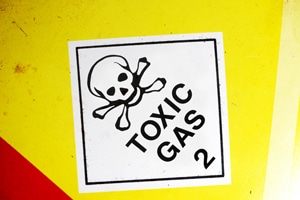
June 25, 2018
Measuring Toxic Gases In The Environment
By Michael D. Shaw
Last month, we presented a historical view of toxic gas detection, that also critiqued the current state of the industry. In this article, we take more of a top-down approach.
Let’s start with a basic taxonomy. Environmental pollution is generally divided into contamination of air and water. Broad brush, air contaminants are either gases or particulates. An “aerosol” is a suspension of ultramicroscopic solid or liquid particles in air or gas (such as smoke, fog, or mist). [Webster’s Third New International Dictionary, Unabridged. 2018.. Web.]
Gases can be harmful in a number of ways. They can be toxic, combustible, or simple asphyxiants. In certain cases, a gas can be both toxic and combustible (although at different concentrations). Department of Transportation regulations, under 49 CFR § 173.115, provide comprehensive definitions of both toxic (gas poisonous by inhalation) and combustible (flammable gases).
A simple asphyxiant is an inert gas that displaces oxygen from air when present in high concentration. In low concentration, they have no physiologic effects. A classic example being carbon dioxide.
While several federal and state agencies have occasion to be involved with air pollution, those of primary interest are the Environmental Protection Agency and the Occupational Safety and Health Administration (OSHA). EPA has defined six Criteria Air Pollutants: Carbon monoxide, lead, nitrogen dioxide, ozone, particle pollution, and sulfur dioxide. The agency has set National Ambient Air Quality Standards for these contaminants, and weighs in on many other substances.
Although it is possible for any one of thousands of toxic chemicals to be in the ambient (normal outdoor) air, the most likely source of such exposure would be in the workplace. As such, OSHA has established permissible exposure limits for more than 500 substances.
There are two basic approaches to measuring concentrations of these substances in air: Wet chemistry, whereby samples are collected in some manner for analysis in the laboratory, and direct-reading instruments. In the case of gases, detector tubes can also be employed.
The EPA, OSHA, and the National Institute for Occupational Safety and Health (NIOSH) publish official wet chemistry test methods for a variety of compounds. EPA’s Air Emission Measurement Center has issued its EMC Promulgated Test Methods. OSHA publishes its in-house Sampling and Analytical Methods, and NIOSH distributes its Manual of Analytical Methods.
In theory, a wet chemistry method could be developed for virtually any chemical, and many old-school analytical purists seem to prefer this approach. However, such methods cannot provide real-time monitoring, and generally introduce a delay in getting results back to the interested party.
Direct-reading instruments utilize some sort of sensor or detector that responds to the target analyte, and that sensor is incorporated into a package of electronics, which provides a display of the analyte’s concentration at that moment. Additional features can include analog or digital outputs; alarm and control functionality; and data logging.
Such instruments range from small wearable personal alarms; to workhorse, midline products such as Interscan’s; to higher-end rigorous analyzers listed as EPA Designated Reference And Equivalent Methods—such as Thermo Fisher’s.
Certain direct-reading instruments are embodied as large, specialized free-standing systems, incorporating an unlimited array of features.
An important facet of all direct-reading instruments is that, unlike wet chemical methods, they must be calibrated against a known standard. Indeed, proper calibration is 90 percent of successful instrument operation. Unfortunately, convenient calibration methods are not available for many key air pollutants; but, this has led to the development of factory-run programs such as SENSOR EXPRESS®.
As instrumentation technology gets more sophisticated and measurement sensitivity improves, the regulatory agencies are driven to lower the established exposure limits for many compounds. Thus, challenges abound for instrument manufacturers.
